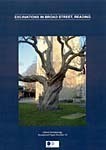Google Books previews are unavailable because you have chosen to turn off third party cookies for enhanced content. Visit our cookies page to review your cookie settings.
Excavations in Broad Street, Reading (Paperback)
Excavations of Medieval and Early Post-Medieval features at 90-93 Broad St, Reading & The Excavation of Medieval Pits and a Probable 16th- to 17th-Century Tavern or Inn
Imprint: Oxford Archaeology
Series: Occasional Paper
Pages: 48
ISBN: 9780904220421
Published: 15th April 2007
Script Academic & Professional
Series: Occasional Paper
Pages: 48
ISBN: 9780904220421
Published: 15th April 2007
Script Academic & Professional
You'll be £6.95 closer to your next £10.00 credit when you purchase Excavations in Broad Street, Reading. What's this?
+£4.99 UK Delivery or free UK delivery if order is over £40
(click here for international delivery rates)
Need a currency converter? Check XE.com for live rates
(click here for international delivery rates)
Need a currency converter? Check XE.com for live rates
Excavations at 7-8 Broad Street, revealed part of a possible 16th- to 17th-century tavern or inn, situated behind the street frontage. Discoveries included a stone built cess pit and a cellar, built in the 16th century and demolished in the 17th century. A large collection of pottery associated with the serving and consumption of drink, fine Venetian-style glassware and a few early clay pipes were recovered from these features. Limited evidence of medieval occupation, in the form of rubbish pits, was also found, but much of the site had been disturbed by the construction of the Corn Exchange in the 19th century. Excavations in 2002 at 90-93 revealed a ditch and evidence for cultivation possibly within the grounds of the Saxon Minster; a small assemblage of early to mid Saxon pottery was recovered from later deposits. Medieval gravel pits, cess pits and a bell mould pit were founded in the back yards of tenements fronting Broad St and Chain St, immediately to the north of St Mary's Churchyard. It is likely that the bell mould pit was for the casting of a 13th-century bell for St Mary's. The pits contained exceptional assemblages of bird, fish and animal bone, suggestive of primary butchery and skinning in the vicinity, as well as the presence of a high status household. There were also notable assemblages of 11th- to 13th-century pottery and 16th- to 17th-century glass.
Customers who bought this title also bought...
Other titles in the series...
Other titles in Oxford Archaeology...


















